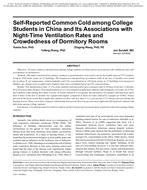Description
Objective: To study common cold infections among college students in China and its associations with ventilation rates and crowdedness in dormitories.
Methods: The study consisted of two phases. In phase I, questionnaires were used to survey the health status of 3712 students living in 1569 dorm rooms on 13 buildings. The frequencies and durations of common colds in the last 12 months were asked for. In phase II, air temperature, relative humidity and CO2 concentration in 238 dorm rooms on 13 buildings were measured. Outdoor air change rates at night when students slept were calculated based on CO2 concentrations.
Results: Two hundred forty nine (7.3%) of the students self-reported to have common colds 6-10 times in the last 12 months,94 (2.8%) more than 10 times. Four hundred thirty six (12.8%) students usually had common colds lasting for 2-4 weeks, 65 (1.9%) had common colds lasting more than 4 weeks. In rooms shared by 6 occupants, the prevalence of common cold infections more than 6 times in the last 12 months was significantly higher, compared to those in rooms shared by 3 people (p<0.002). Ninety percent of the dorm rooms had a night-time outdoor air flow rate less than 8.3 L/s per person (17.6 cfm per person) during the heating season. There was a dose-response relationship between air flow rate per person at night and self-reported common cold infections among college students.
Conclusion: Crowded dormitories with low outdoor air flow rate per person means more respiratory infections among college students.
Citation: IAQ Conference: IAQ 2010: Airborne Infection Control
Product Details
- Published:
- 2011
- Number of Pages:
- 6
- File Size:
- 1 file , 560 KB
- Product Code(s):
- D-IAQ2010-C146-10




